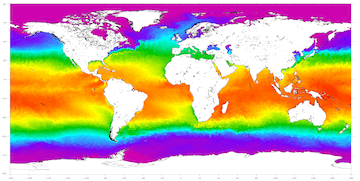440217-getting colder.gif

The northern Atlantic Ocean has experience a chilldown recently. Credit: National Oceanic and Atmospheric Administration
Parts of the northern Atlantic Ocean have experienced a chilldown in recent years. In particular, a large pool of water between Canada and Europe has cooled by about three-quarters of a degree. And some researchers say that could lead to drier conditions across the Atlantic.
Researchers in Britain studied not only the changing temperature, but changes in the way water flows around the north Atlantic at different depths. Warm surface water flows northward in the Gulf Stream, past the East Coast of the United States, then eastward to Europe. In the north Atlantic, that flow gets colder and denser, so it sinks. It then flows southward past Europe and northern Africa, then ultimately back toward the U.S. as it warms up.
For years, this circulation was especially strong. At the same time, the water near the top of the ocean between Canada and Europe got warmer. But the British scientists found that over the last decade, both trends have reversed. The circulation around the Atlantic has weakened, and the northern waters have cooled.
Both results could be caused by changes at the bottom of the ocean between Canada and Greenland. Those waters have gotten warmer and less salty, at least in part thanks to melting glaciers in Greenland. That could be slowing the circulation.
The researchers say that the North Atlantic could get even cooler over the next few years. That might suppress the number of hurricanes, but rob parts of Europe and Africa of rain -- another example of the link between land and sea.

